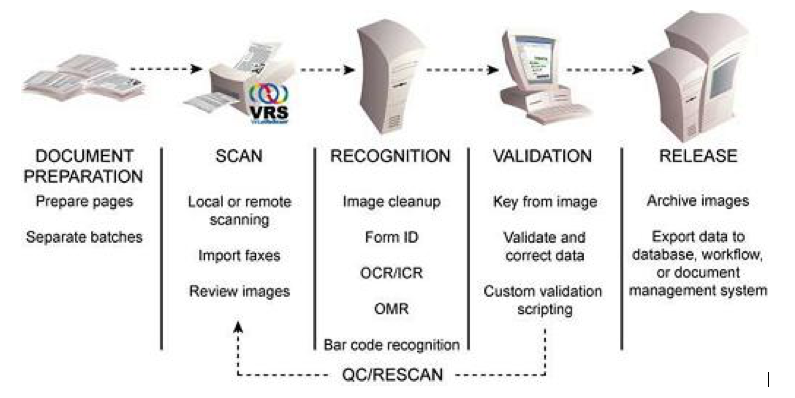-
 Kofax CaptureThe Leading Solution for Multichannel Capture
Kofax CaptureThe Leading Solution for Multichannel Capture
OCR as a technology provides the ability to successfully capture machine produced characters in pre-set zones or, full page. OCR systems can recognise many different OCR fonts, as well as typewriter and computer-printed characters. Dependent upon the capabilities of the OCR product, this can be used to capture low to high volumes of data, where the information is in consistent location(s) on the documents.
ICR (Intelligent Character Recognition)
ICR is the computer translation of hand printed and written characters. Data is entered from hand-printed forms through a scanner, and the image of the captured data is then analysed and translated by sophisticated ICR software. ICR is similar to optical character recognition (OCR) but is a more difficult process since OCR is from printed text, as opposed to handwritten characters.
Barcode recognition
Dependent upon the type of barcode that is used, the amount of metadata that can be included is high, as is the level of recognition. The application of single or multiple bar codes to particular document types such as Proof of Delivery notes, membership forms, application forms, gift aid, can dramatically increase the effectiveness of a business process.
Greenboro designs to meet your specific business requirements, our solutions use Tier 1 products that have been proven across thousands of installations worldwide. We then configure these around your individual process, and integrate with any existing systems – based on a technical and business discovery by our experienced analysts. This enables fast implementation, with highly individual specifications and high rates of return on investment.
The Greensboro provides data capture solution can significantly reduce your retrieval costs while improving regulatory and compliance efforts. It is flexible and scalable, enabling customers to define where and how images are captured and indexed, whether in a home office, remote branch or back office data centre.
Kofax - The Leading Solution for Multichannel Capture
Kofax Capture™ products (Kofax Capture, Kofax Transformation) provide a standard, automated and consistent process for securely capturing all types of inbound documents and information, wherever it is first available — whether a central office or digital mailroom, from a customer's home, a local branch office or even remotely from a smartphone or tablet.
They accelerate business processes by collecting documents and forms, transforming them into accurate, actionable information, and delivering it into your line of business applications, workflows, repositories and databases. Whether information is on paper or in electronic files, in a central office or scattered on desktops and remote offices throughout the world — Kofax captures it all quickly and accurately, ensuring complete chain of custody of the content and accelerating core business processes and solutions.

Kofax Capture™ automates and accelerates business processes by capturing all types of paper and electronic documents and forms, transforming them into accurate and actionable information, and delivering it all into core business applications, processes and workflows.
This can significantly reduce retrieval costs while improving regulatory and compliance efforts. Kofax Capture is flexible and scalable, enabling customers to define where and how images are captured and indexed, whether in a home office, remote branch or back office data center.
Kofax Transformation™ adds automatic document classification, page separation, data extraction and validation capabilities to Kofax Capture™. It eliminates the time and human effort required to understand the large volumes of documents and the related information. Once data is extracted, it is routed to the appropriate systems and staff within the organization.
By automating what were previously error-prone and time-consuming tasks, the system can significantly reduce labor costs, improve information quality and accelerate business processes. It replaces expensive document sorting, filing and data entry processes to significantly increase productivity and accelerate throughput of data collection.
